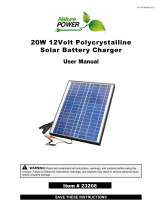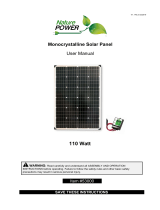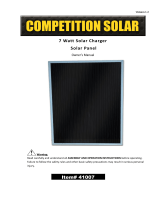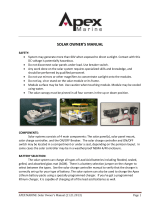
gpelectric.com | [page 13]
®
Topic
Issue Possible Cause How to Tell Remedy
Problems with
the Display
Display is blank Battery or fuse
connection and/or
solar array connection
(daytime only) or battery or
fuse connection
(nighttime only)
1. Check voltage at controller battery
terminals with a voltmeter. Compare with
voltage reading at the battery terminals.
2. If there is no voltage reading at
controller battery terminals, the problem is
in the wiring between the battery and the
controller. If the battery voltage is lower
than 6 volts the controller will not function.
3. For the solar array, repeat steps 1 and
2 substituting all references to battery
terminals with solar array terminals.
Check all connections from the
controller to the battery including
checking for correct wire polarity.
Check that all connections are clean,
tight, and secure. Ensure the battery
voltage is above 6 volts.
Display shows
nighttime during
the day
Panel is covered by
something; PV panel is
too dirty to supply a high
enough voltage to charge
the battery; PV panel is not
connected
1. Check the panel and ensure it is not
obscured.
2. Check that PV cables are connected to
the controller.
Clean the panel if it is dirty.
Connect PV cables to controller if
not connected.
Problems with
the Voltage
Inaccurate
voltage reading
Excessive voltage drop
from batteries to controller
due to loose connections,
small wire gauge or both.
1. Check the voltage at the controller
battery terminals with a voltmeter and
compare with the voltage reading at the
battery terminals.
2. If there is a voltage discrepancy of
more than 0.5V, there is an excessive
voltage drop.
Check all connections from the
controller to the battery including
checking for correct wire polarity.
Check that all connections are
clean, tight and secure. Shorten the
distance from the controller to battery
or obtain larger gauge wire. It is also
possible to double up the existing
gauge wire (i.e. two wire runs) to
simulate a larger gauge wire.
Q3. My voltmeter shows a different reading than the GP-PWM-10 display
A. The meter value on the GP-PWM-10 display is an approximate reading intended for indication purposes only. There is an
approximate 0.1 volt inherent error present that may be accentuated when compared with readings from another voltmeter.
There may be a slight difference between the battery voltage displayed on the GP-PWM-10 display and the battery voltage measured
at the battery terminals. When troubleshooting using a voltmeter, check both the battery voltage at the controller terminals and battery
voltage at the battery terminals. If a difference of more than 0.5 volts is noted, this indicates a large voltage drop possibly caused by
loose connections, long wire runs, small wire gauge, faulty wiring, a faulty voltmeter or all the above. Check all connections.
How to Read this Section
Troubleshooting Problems is split into three sub-sections, grouped by symptoms involving key components. A multimeter or voltmeter
may be required for some procedures listed.
It is imperative that all electrical precautions outlined in this manual are followed. Even if it appears the system is not
functioning, it should be treated as a fully functioning system generating live power.
FREQUENTLY ASKED QUESTIONS
10.TROUBLESHOOTING
























